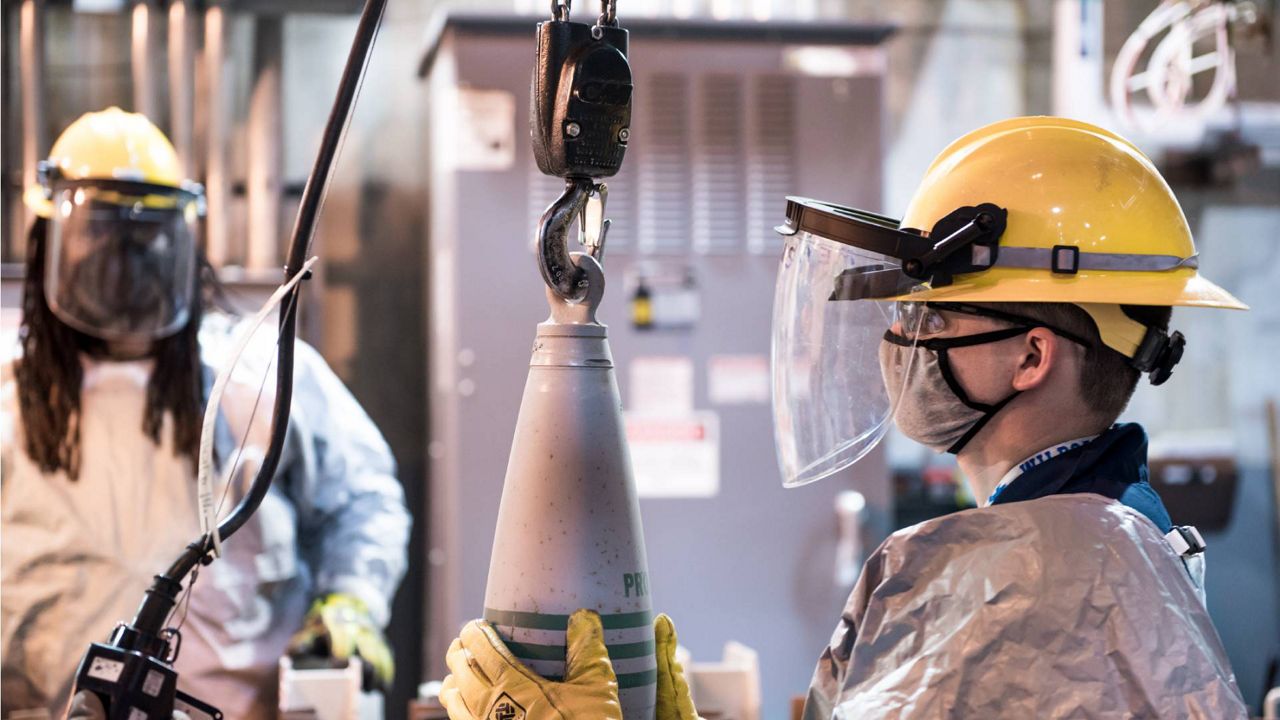KENTUCKY — According to a release from the Blue Grass Chemical Agent-Destruction Pilot Plant (BGCAPP), its team destroyed the last of the 155mm projectiles containing VX nerve agent on May 28.
What You Need To Know
- BGCAPP team destroys the last of the 155mm projectiles containing VX nerve agent on May 28
- Teams will now focus on completing the destruction of mustard-filled projectiles and preparing for the destruction of nerve agent-filled rockets
- Destruction operations of the projectiles began at the Blue Grass Army Depot on Jan. 10, 2021
- BGCAPP personnel coordinated with the Blue Grass Chemical Activity (BGCA) personnel on the transport of the projectiles from storage igloos on the depot to the plant
“There are two important milestones to recognize here,” said Dr. Candace Coyle, BGCAPP site project manager. “This marks not only the completion of the second of five destruction campaigns in Kentucky, but also the destruction of all projectiles containing nerve agent in the U.S. chemical weapons stockpile.”
BGCAPP teams will now focus on completing the destruction of mustard-filled projectiles and preparing for the destruction of nerve agent-filled rockets.
Destruction operations of the VX 155mm projectiles began at the Blue Grass Army Depot (BGAD) earlier this year on Jan. 10, 2021. Automated equipment disassembled nearly 13,000 munitions and drained the chemical agent under the observation of trained operators, the release said. The agent was neutralized by mixing it with water and caustic to produce hydrolysate, which was pumped to holding tanks to be processed later at an off-site disposal facility after the agent was confirmed destroyed. The remaining metal parts from the munitions were decontaminated and recycled.
“The VX projectile campaign marks the second time our team has safely completed a munitions destruction campaign during a pandemic,” said Ron Hink, Bechtel Parsons Blue Grass (BPBG) project manager. “Our experience in safely destroying projectiles puts us on the right path forward to begin safely destroying rockets containing nerve agent later this summer.”
BGCAPP personnel coordinated with the Blue Grass Chemical Activity (BGCA) personnel on the transport of the projectiles from storage igloos on the depot to the plant.
“The partnership between BGCA’s experienced chemical operations personnel and BGCAPP keeps things running smoothly,” said BGCA Commander Lt. Col. Ed Williams. “BGCA is proud to be a part of this milestone, and we look forward to supporting the next phase of destruction.”
Col. Steve Dorris, BGAD commander, called the achievement a milestone.
“For the first time since the early days of our involvement in the Vietnam War, we can all proudly say that chemical weapon nerve agent projectiles now no longer exist, not only in central Kentucky, but in the entire United States,” he said.
BGAD's chemical weapons stockpile originally consisted of 523 tons of chemical agent configured in 155mm projectiles containing mustard and VX nerve agent, 8-inch projectiles containing GB nerve agent and M55 rockets containing GB and VX nerve agent.
The BGCAPP team began destroying the mustard stockpile using the Static Detonation Chamber, an explosive destruction technology, in June 2019. The release said the mustard campaign is more than 85% complete. Nearly 4,00 8-inch projectiles containing GB nerve agent were destroyed ay BGCAPP from January through May 2020, the release added.
More than 27% of the original 523 tons of chemical agent have been destroyed in Kentucky, as of May 21.
The Program Executive Office, Assembled Chemical Weapons Alternatives is responsible for destroying the remaining U.S. chemical weapons stockpile in Colorado and Kentucky. The organization oversees the contract for design, construction, systemization, operation and closure of BGCAPP with BPBG and subcontractors Amentum, Battelle Memorial Institute and GP Strategies.
The stockpile sites in Colorado and Kentucky account for the last 10% of what was originally a national stockpile of more than 30,000 tons of chemical weapons, the release said. The U.S. Army Chemical Materials Activity destroyed the initial 90%, which was stored at seven other sites across the U.S. and on Johnston Atoll in the Pacific. Chemical weapons destruction in Colorado began in 2015. Both sites are on target to complete the destruction of chemical weapons by Dec. 31, 2023.



